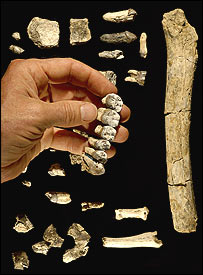Avi Blizovsky

Fossil hunters have found the remains of what was probably one of the direct ancestors of modern humans, who lived about 4 million years ago. The bone samples of the ancient creature helped to bridge a large gap in human knowledge about the critical period in human evolution.
Prof. Tim White from the University of California at Berkeley and his colleagues uncovered the fossil accumulation in the central Awash region of Ethiopia. They described the findings, which belong to the species Osperlipitcus anamensis in the journal Nature. Austrapithecus is a future and important stage in the history of the hominids. It is commonly thought that our species, Homo, evolved from this group, so the relationship between Australopithecus and the two-legged creatures that preceded it is essential to answering the question of where we came from.
When compared to other fossils from the same area in Ethiopia, the 4.1 million year old creature appears to be an evolutionary intermediate stage between earlier and later creatures.
The find closes a gap between older creatures known as Aridpithecus ramidus, which lived 4.4 million years ago, and a later creature - Australipithecus afarensis, which lived 3.4 million years ago in the central Awash region. The researchers say that Australopithecus anamensis is an intermediate creature between the two not only chronologically but also in terms of its anatomy.
The amenemesis species is not new, but the researchers say this is the first time they have seen all three species in a continuous series in one place.
One explanation is that one species evolved into another, a feature known as phyletic evolution. Another possibility is that Australopithecus initially appeared as an offshoot of Ardiphyticus. According to this hypothesis, the parent species lived alongside the species that gave birth for a certain period before becoming extinct, but no overlap between the three species was discovered in Ethiopia.
"The relational evidence shows that the species evolved from each other, and that we were able to capture the beginning of the second stage in human evolution - the beginning of Australopithecus." White explained. However, he added, "we cannot yet rule out the alternative hypothesis". said.
The new discovery also makes it possible to cover the gap between Ardipithecus and Australopithecus, but not completely. "You cover one gap and create two new ones" said Prof. White. Now the gap has narrowed and instead of a million years (4.4 to 3.4), there is now a gap between 4.4 million and 4.1 million. These 300 years are a long time when it comes to human scale, but not geological scale." said.
The fossils represent at least eight individuals and are in the largest hominid assemblage ever found, including the earliest femur of Australopithecus, as well as leg bones.
Bones of pigs, monkeys and large cats were also found at the site, indicating that the inhabitants lived in a closed forested environment.
Amenensis has a thick layer of enamel on its teeth, indicating that it feeds on abrasive roots. In many species this is a deterioration in nutrition and this means that the sources of food have dwindled, but it is not clear what caused the diversion of nutrition in this case.
For news at the BBC
They know evolution - the rise of man
https://www.hayadan.org.il/BuildaGate4/general2/data_card.php?Cat=~~~449528123~~~51&SiteName=hayadan

One response
The evolution of this species was probably particularly wild, because in the article the following occur simultaneously:
Osperlipitcus
Austrapithecus
Australopithecus
Australipithecus
Australopithecus
And if I forgot any of them, this is probably evidence that I am "amnesis" too.